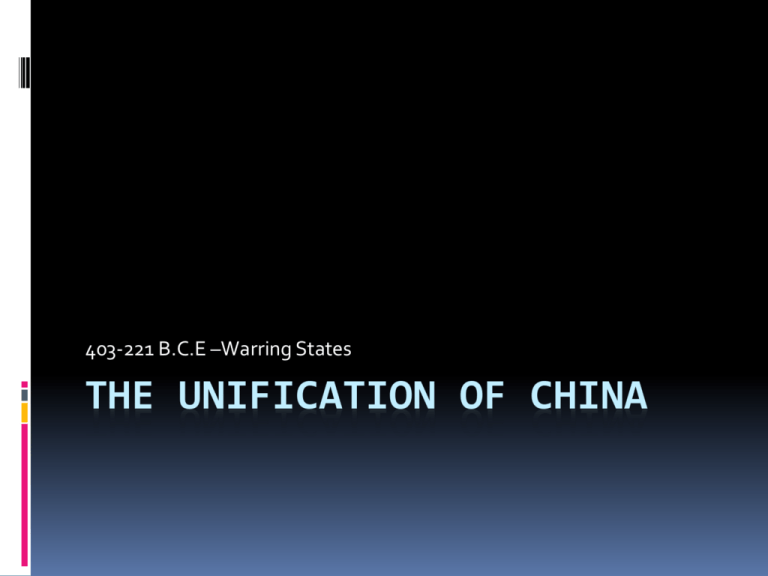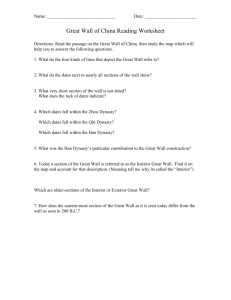
403-221 B.C.E –Warring States
THE UNIFICATION OF CHINA
Unification of ChinaObjectives
Concept 2.1 -The Development and
Codification of Religious and Cultural
Traditions
New belief systems and cultural traditions
emerged and spread, often asserting
universal truths.
Belief systems affected gender roles (such as
Buddhism’s encouragement of a onastic life
or Confucianism’s emphasis on filial piety).
Unification of ChinaObjectives
Concept 2.2 –The Development of States and
Empires
The number and size of imperial societies grew
dramatically by imposing political unity on areas
where previously there had been competing
states.
The Roman, Han, Maurya and Gupta empires
created political, cultural and administrative
difficulties that they could not manage, which
eventually led to their decline, collapse and
transformation into successor empires or states.
Unification of China
Objectives:
Use persuasive techniques that include
point of view
Explain the tenets of Chinese philosophy
Illustrate the meaning of the words ren,
li, or xiao
Analyze the Analects from Laozi’s writings
Bellringer: How can bureaucracy be beneficial
to the formation of a society? (in notebook)
Unification of China
Agenda
Geography Skills-Qin kingdom, Qin dynasty
and Han dynasty
Dynasty Song
Inspirational Posters
Unification of China
Agenda
Geography Skills-Qin kingdom, Qin dynasty
and Han dynasty
Dynasty Song
Inspirational Posters
Unification of China
Geography Skills-Qin kingdom, Qin dynasty and
Han dynasty
Using the maps in the text and a blank map of the
eastern hemisphere (or perhaps just Asia), draw
and label the borders of the Qin kingdom in the
Period of the Warring States, the Qin dynasty,
and the Han dynasty including tributary states.
Include a label of Korea and Vietnam in your map.
Confucius and His Thoughts
system of beliefs focusing on moral and
ethical issues.
not considered a religion by some since there
is not a God
political and social order
the junzi, “the superior individuals,”
Ren (humanity and kindness)
Li (courtesy, respect, and deference to elders)
Xiao (Filial piety and familial obligation)
Confucius
Aristocratic roots
Unwilling to compromise principle
Decade of unemployment, wandering
Returned home a failure, died soon thereafter
Teachings: Analects
Competing Religions
Confucianism
Daoism
Legalism
Active
Yielding to the
Agriculture
and the
military
Shang Yang
and Han Feizi
Harsh
penalties
Needs of the
state
Not popular
Brought end to
Warring Period
approach
Confucius
forces of nature,
your needs are met
Laozi
Unification of China
Qin Dynasty
Qin Shihuangdi
organized a powerful army and unified China in 221
B.C.E.
established centralized imperial rule, extended the
Great Wall, and standardized the currency and law
Han Dynasty
Han Wudi, the Martial Emperor
utilized Legalist polices, established a huge
bureaucracy and monopolies, and expanded taxes
to keep control
Han Dynasty (continued)
expanded their
empire into
Korea, Vietnam,
and into the
northern steppes
rapid population
growth,
increased taxes
and social unrest
Problems with
land distribution
Yellow Turban
Revolt in 220 C.E.
China Under the Qin Dynasty,
221-207 B.C.E.
©2011, The McGraw-Hill Companies, Inc. All Rights Reserved.
13
Tomb of the First Emperor
©2011, The McGraw-Hill Companies, Inc. All Rights Reserved.
14
Silk Roads
Included merchants, missionaries, nomads, and
soldiers from all over the eastern hemisphere
Trade was conducted in relays from oasis to oasis or
port to port
Relatively few people traveled the routes from one
end to the other
Transportation (camels, foot, horses, boats)
Foreign merchants often had their own
quarters/neighborhoods in the trading cities in China
Travelers most benefited after the Period of the
Warring States
The Great Wall of China
Panoramic View
Expert Group Presentations
In your assigned group you will choose one of
these topics for an inspirational poster
1. Illustrates why the tenets of one philosophy
in this chapter would be the best one to adopt.
2. Illustrates the meaning of the Confucian
ideas of ren, li, and xiao.
3. Research, illustrate and explain a verse from
the Analects of Confucianism or from Laozi’s
writings.










